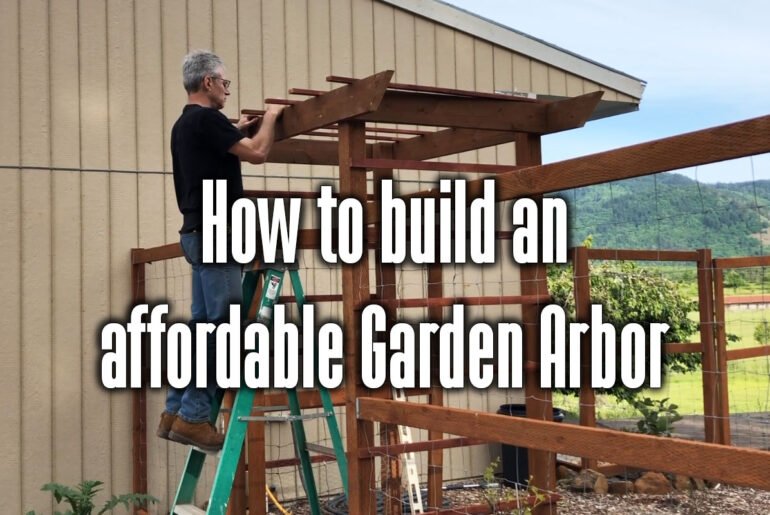Even a small garden arbor may be costly if you buy it prebuilt or hire a landscape carpenter to create it according to your instructions. Fortunately, this is one of your garden’s simplest (and cheapest) do-it-yourself projects.
Our design requires only a basic four-post structure for a tiny patio or an overhead shelter for a garden bench. The design is straightforward: four vertical 4×4 posts; two horizontal beams built from pairs of 2×6 boards sandwiched around each post at the top; a set of 2×4 “rafters” that span the joists and run parallel to them; and, finally, 2×2 lattice strips that span the rafters. The end result is an overhead screening structure with beautiful dappled shade or a foundation for a vine canopy.
The Fundamentals of Arbor Construction
If you remember five stages in the construction process, building this arbor will be much easier:
- Four-post foundations will require the excavation of four holes.
- Concrete has been poured into the holes to embed 4×4 posts in a perfect (plumb) vertical posture.
- At the top, sandwiching pairs of 2×6 crosspieces together serves as beams for the surrounding opposite pairs of posts.
- 2×4 “rafters” are installed to span across the sandwiched beams.
- Over the rafters, install 2×2 lattice strips as a flat roof surface that is parallel to the rafters.
Depending on the size and sort of wood you choose, your arbor’s expenses can vary significantly. The price of an arbor constructed from 6×6-foot pressure-treated pine lumber will be far lower than the cost of a 10×10-foot arbor built with top-grade cedar or redwood timber. If you’re constructing a larger arbor, the structural wood size will need to be increased. For example, a 12×12 arbor may require 6×6 posts, 2×8 or 2×10 beams, and 2×6 rafters, depending on the size.
While the tasks aren’t particularly complex, you’ll need some accuracy to plumb the posts and secure the beams and rafters in position. This job will be considerably less difficult if you have the assistance of two or three people.
Before Getting Started
We’re constructing a 7 to the 8-foot-tall arbor with an open area of 8 feet square between the posts in our example. Six 10-foot-long rafters set 2 feet apart span over the structure on top of the beams. Finally, there are 11 2×2 lattice strips to create open grid-like roofing.
However, you may customize this design to meet your own needs by changing the materials list as needed. If you choose to construct a smaller arbor, such as one that would cover a tiny walkway, your expenses will be lower.
Make sure the wood is insect resistant and decay-resistant. The most low-cost option is pressure-treated pine, which has been chemically treated to prevent insect damage and decay. Pressure-treated wood can be painted or stained after a short drying period. Others, such as cedar or redwood, have a natural resistance to decay and are more costly.
What You’ll Need
Equipment / Tools
- Post-hole digger
- Wheelbarrow or mortar mixing tub
- Shovel
- Hoe
- Tape measure
- Level
- Hammer
- Saw (power miter saw is suggested, but any saw will work)
- Jigsaw (optional)
- Drill with screwdriver bits & a 1/4-inch spade bit
- Stepladder
- Wrench
- Safety gear (work gloves and eye protection)
- Chisel
Materials
- Bags of ready-mixed concrete
- Drainage grave
- l4 4×4 posts
- Four 2×6 boards for beams
- Six 2×4 boards for rafters
- Eleven 2×2 boards for lattice
- Eight 1/4-inch bolts, 6 inches long, with washers and nuts
- Two 1/2-inch deck screws
Instructions
1. Dig Post Holes
The first step is to find and excavate holes for the posts. The spacing between the poles may differ, but this straightforward concept keeps the posts no more than 8 feet apart. For sturdiness, embed your posts at least 2 feet deep. Always check with the local building inspection office to find out if there are any restrictions on post depth. Whatever is required in your region, follow it.
Use a post-hole digger to drill holes for the post foundations after establishing the position of the posts on the ground. To assist drainage, add several inches of gravel to the bottom of each hole.
2. Position the Posts
The project’s first (and most time-consuming) step is ensuring that the posts are properly installed and firmly secured. Take your time on this area of the project. A helper can be quite beneficial during this phase of construction.
For posts, if necessary, cut 4×4 wood to length for the portion that will be below ground. Most carpenters prefer to chop posts a little longer than required, then trim the tops of the posts to the correct height on completion. After that, insert the posts in the footing holes, ensuring that the distances between them are consistent. The posts must create a perfect square area.
3. Anchor the Posts
Mix the concrete in a mortar box or wheelbarrow. The consistency should be that of dough — not too wet or dry. Shovel wet concrete into the hole to the ground level, with a helper holding the post upright (or steadying it). When you’re putting in concrete, be sure the post is level (plumb) with a level to make sure it stays that way. Tap the side of a post lightly with a hammer to settle the concrete and eliminate any air pockets.
When you’ve finished adjusting the first post, avoid touching it while moving to the next one. If the pole sways or cannot remain upright, attach it with diagonal stakes secured with screws.
Continue to the following post. You must install it correctly so that the front faces of both posts are parallel. A long straightedge board can be utilized to ensure that the posts’ faces are aligned.
Next, go to the final two posts and make sure the spacing is consistent and that all post faces are perpendicular. Allow the concrete to dry overnight once all posts have been set up. When the concrete has dried, take care to prevent the posts from being knocked or relocated.
4. Cut and Attach the Beams
The arbor’s two cross beams will be made up of a pair of 2x6s sandwiched around each of the posts near the top. (For small arbors, wooden beams of this design may be constructed from two 1×6 pieces).
The first step is to cut four 2x6s to the correct arbor “roof” width. However, it’s okay if the beams overhang the posts by up to 1 foot. If the beams are 10 feet long, for example, so that there is a 1-foot overhang on each side, the posts should be 8 feet distant.
Put a mark indicating the bottom of the joists by measuring from the ground up along each post. Although this is a personal choice, it’s best to measure 7 to 8 feet in length. This is because people may crawl under it without hitting their heads on the edges.
The beams can now be positioned and temporarily fastened to the posts, ensuring that they are perfectly level and aligned with one another. Level the beams from side to side using a long straightedge and a level.
After you’ve positioned the beam pieces as desired, drill two 1/4-inch holes through the joists and sandwiched beams, then insert lag bolts through the holes and connect the three layers with washers and nuts. Install two bolts on each beam pair to secure it to its post.
If the posts are sticking out above the top of the joists, you can now cut them flush with a handsaw, jigsaw, or reciprocating saw.
5. Attach Rafters
The beams of this arbor are supported by six parallel 2×4 rafters that overhang slightly on either side. Again, the rafter length is entirely up to you, but it should not overhang the outside of the joists by more than 1 foot. This design necessitates a bespoke feature in which the rafters are nipped to fit over the joists, and this step may also be skipped to reduce labor.
Cut the rafters for the 2x4s to length. The first rafter should be placed across the tops of the beams so that the overhangs on each end are consistent. On the edge of the rafter, describe where the sandwiched beams will be located.
Remove the rafter and make marks on the face for 3/4-inch wide x 1 1/4-inch deep notches at each beam. Make the depth cuts for each notch first with a handsaw or circular saw, then use a chisel to remove the wood and finish the notch.
Repeat the procedure with each of the other rafters. Tap the rafters into place, then tap them down to ensure the beams are entirely buried in the notches. Make sure the rafters are equidistant along with each pair of joists.
Two 1/2-inch deck screws should be driven into the top face of the rafters from above to secure them to the beams.
6. Attach Lattice Strips
The 2×2 lattice strips are cut and attached as the top architectural layer above the rafters, positioned perpendicular to the rafters. The spacing and quantity of strips are up to you, although a 6- to 12-inch space is usually best. If the first and last lattice strips are flush with the 10-foot rafters’ ends, we’ll need 11 lattice strips, assuming there are 12 inches of space between posts.
To make the lattice strips:
- Cut 2x2s to length.
- Arrange the lattice strips on the rafters, ensuring an equal distance between them.
- Secure the lattice strips to the rafters with deck screws inserted from above.
7. Finish the Arbor
If you constructed your arbor from pressure-treated wood, allow at least six months before staining. Because of the time required, you won’t be able to grow vines on the arbor for the first summer. Staining isn’t needed if you’re using cedar or redwood construction materials, and the plants can be planted right away.




2 Comments
Pingback: What is an Arbor used for? - Discover the yard
Pingback: What’s the Difference Trellises, Arbors, and Pergolas - Discover the yard